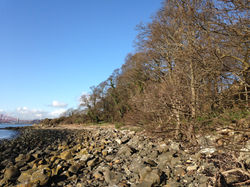Nettles don’t all sting

Plants are growing fast now and more are coming into flower. Two that we are lucky to have a good number of in Dalgety Bay are Red and White Dead-nettle and they have been starting into flower for a few weeks already. The nettle in the name refers to the leaf shape and when they are not in flower it can be difficult to tell them apart, but the Stinging Nettle leaves are sharper in outline and are not as hairy and so don’t look as soft. Importantly for us, Dead-nettles don't sting.
The Dead-nettles are part of the Mint family of plants and, unlike Stinging Nettles which are wind pollinated, have clusters of coloured flowers beneath the leaves. These early flowers are particularly important for Bumblebees as they provide nectar for the queens emerging from their long winter hibernation.

Red Dead-nettle is the smaller of the two and flowers earlier. It is an annual and is usually found on path edges or disturbed ground.

The smaller flowers are of a good size for Early Bumblebee queens to feed from. They are the smallest of the 7 common bumblebees to be seen in Dalgety Bay.

White Dead-nettle is much larger and is a perennial, dying back to white underground runners in the winter. These also allow it to spread, so it is often seen in quite large clumps of plants.
Flower use by bumblebees was surveyed in 2015 on a circuit around our wildflower areas and woodlands; all 6 species present at the time were making use of White Dead-nettle in the Spring season. This makes it a particularly important species to have in any wildflower area.

Common carder queen with her head deep inside a White Dead-nettle flower in April 2015

Red-tailed queen visiting White Dead-nettle in April 2015

Its importance is even greater for one of the rarest of the common bumblebees, the Garden Bumblebee, distinguishable by the band of yellow hairs in front of the wings.
This species is only seen in significant numbers over the year where there are White Dead-nettles in flower in the spring. Because of the abundance of this flower around the edges of our woodlands, together with another flower that is important for this bee, Foxglove, there are more Garden Bumblebees to be seen around Dalgety Bay than even in the insect survey sites around the Loch Leven National Nature Reserve that have been surveyed in detail each year since 2008.
It is expected that the newcomer, Tree Bumblebee, that featured in a previous post, may also use this flower and it had been intended to carry out a repeat of the 2015 survey to see how this species was fitting in with the others, but this will now have to wait until next year.
Usefully, White Dead-nettle also has a very long flowering period from April through to June, and a second smaller flowering peak in late August to early September this latter characteristic making it important for feeding bumblebee queens in readiness for hibernation.
Altogether, we should cherish these two flower species and celebrate their role in supporting our bumblebees. That does not mean that Stinging Nettles do not also have a wildlife benefit, but more on that in a future post.







































